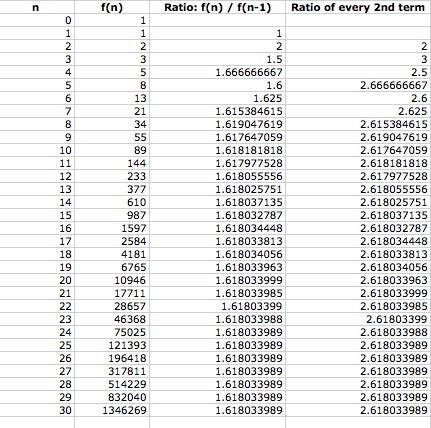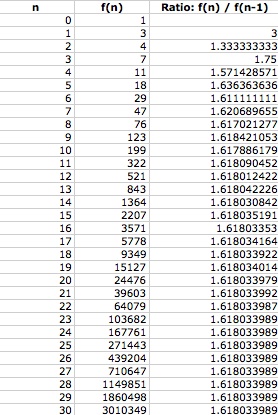

Assignment 12: Fibonacci Sequence
Presented by: Amanda Oudi
Many patterns in mathematics can be described using sequences. One such sequence is known as the Fibonacci sequence, which is a series of numbers satisfying the relation: f(0) = 1, f(1) = 1, and
f(n) = f(n-1) + f(n-2). Let's explore the
Fibonacci sequence using Microsoft Excel.
Open
a new spreadsheet. In the first column, input 1 and 1 to represent the f(0) and
f(1) values. Then we can generating all other terms by using the relation f(n)
= f(n-1) + f(n-2).

Looking
at the values produced in the spreadsheet, it seems that as n increases, it
converges to a particular value. I actually recognize the value as the Golden
Ratio, but let’s prove that the ratio of successive terms in the Fibonacci
sequence converges to the Golden Ratio.
Let x = limit of f(n) as n approaches infinity

We only consider the
positive case here. Hence, our sequence converges to the Golden Ratio.
We see that the ratio of every second term converges to a different value. Conjecture: Using the Fibonacci sequence, the ratio of every second term converges to 1 + Golden Ratio. A similar proof to the one above can be shown.
Now, let f(0) = 1 and f(1) = 3. This is known as the Lucas sequence. Let's compare the ratio of successive terms. Looking at the values produced in the spreadsheet, it seems that as n increases, it converges to the same value as the previous example. This value is again the Golden Ratio.

Now, you investigate some other cases where f(0) and (1) are some arbitrary integers other than 1 using an EXCEL spreadsheet. What do you notice about the limit of the ratio of succesive terms?